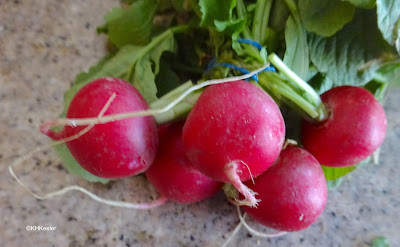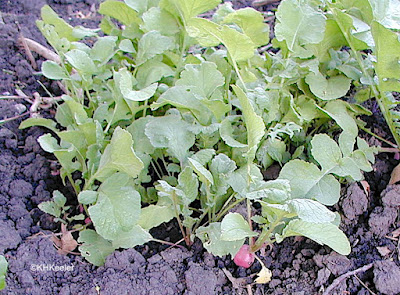The radish is an ancient vegetable that has been mainly reduced to a garnish.
 |
| radishes, Raphanus sativus |
 |
| radish, Raphanus sativus |
Radishes are biennial, flowering in their second year. Red, white, or red-and-white little round radishes are harvested the first year. The radish for which we grow the plant is where the plant stores energy from its first year of life to help with flowering the next year. Allowed to grow on after the radish first forms, it will become tough and pithy. Seeds are produced only in the second year and seed companies generally do that for casual gardeners. Other radishes are grown for their leaves or roots and you could eat the leaves and seed pods of your garden radish, but they are nowhere near as tasty as the round radish.
 |
| radish, Raphanus sativus |
The word radish is derived from the Latin for root, radix. It sounds like "reddish," but the name is far older than the red-colored root, going back to Old English, and the name is shared with most European languages. Raphanus was the classical Greek name for radish, and sativus means "edible" "cultivated." (thanks, David Gorsline). It is in the mustard family, Brassicaceae, and the sharp taste comes from glucosinolates, myrosinases, and isothiocyanates shared with mustards.
 |
| radish, Raphanus sativus |
In 1653 Nicholas Culpeper wrote that the garden radish is "so well known it needs no description." (p. 287). He and his contemporaries disparaged the radish; "it does not give much nourishment, and is very windy" he continued. Thomas Hill, writing a garden book in 1652, said "radish eaten before or after meat, causeth wind, dulleth the braine, eyes, and reason" (Mabey, p. 211).
However, from ancient times, radishes were considered good medication for gall and kidney stones. Their chemistry lets them store well, and they hold enough vitamin C through the winter to be a year-round antidote to scurvy. These uses are supported by modern science, but other claims haven't been verified. Radishes reportedly induced lust, which as a healthy vegetable, they might, if by lust they meant sexual energy. More doubtful are curing poisons and snakebites, removing freckles and restoring hair. The Leech Book of Bald (English, about the year 1000) stated: "Against a woman's chatter: taste at night fasting the root of a radish, that day the chatter cannot harm you."(III-lvii). Carried, radishes protected against the evil eye.
 |
| radish plants, Raphanus sativus |
Comments and corrections welcome.
References
Cockayne, T. O. 1961. Leechcraft, Wortcunning and Starcraft of Early England. The Holland Press. London.
Culpeper, N. No date given, original 1653. Culpeper's Complete Herbal. W. Foulsham and Company. London. Online version: link From at 1810 edition.
Cunningham, S. 1985. Cunningham's Encyclopedia of Magical Herbs. Llewellyn Publications. St. Paul, Minnesota.
Harrison, L. 2011. A Potted History of Vegetables. Lyons Press. Guildford, Connecticut.
Mabey, R. editor. 1987. The Gardeners Labyrith by Thomas Hill. (originally published 1652). Oxford University Press. London.
Oxford English Dictionary Online. 2022. "radish, n.". OED Online. Oxford University Press. https://www-oed-com.libproxy.unl.edu/view/Entry/157346?redirectedFrom=radish (accessed March 19, 2022).
Storl, W. D. 2016. A Curious History of Vegetables. North Atlantic Books. Berkeley, California.
Van Wyk, B-E. 2005. Food Plants of the World. Timber Press. Portland, Oregon.
Kathy Keeler, A Wandering Botanist
More at awanderingbotanist.com
Join me on Facebook: https://www.facebook.com/AWanderingBotanist
I have always read sativus/a as "cultivated."
ReplyDeleteyes. You are right! I relied on memory and didn't check. Thank you.
Delete